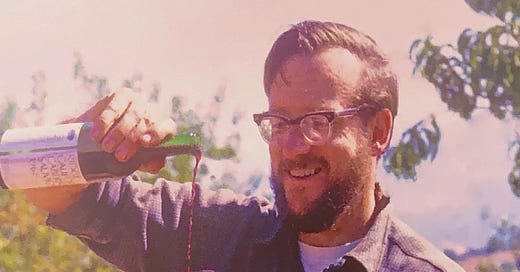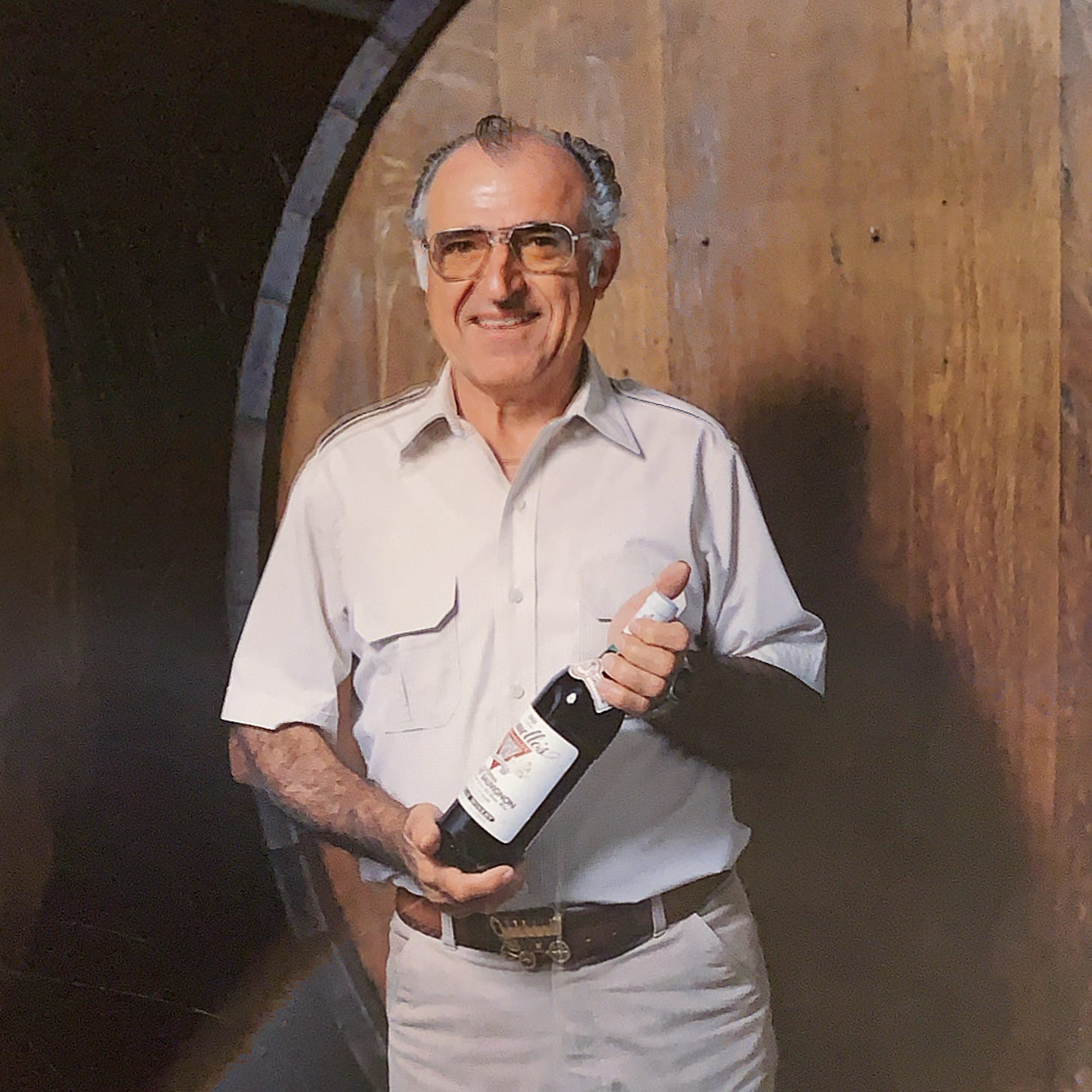Reefers in the Vineyard
From the Montebello Road diaries, a winemaker finds more than just grapes growing in his vineyard.
👋 Hello, I’m Kevin Ferguson, author of 🍷 Rain on the Monte Bello Ridge,🍷 my forthcoming memoir about health, aging and winemaking. (Read the book's origin story.) 🍇 The Centenarian Playbook is my newsletter, which features longevity tips and stories from Grandma Kay’s long life. It also includes stories of the Gemello Winery, which her late husband, Mario, ran for nearly half a century. 📖 I’m sure you’ll find my maternal grandparents are quite lovable characters. You can subscribe by clicking on this handy little button.
This newsletter is published twice a month on Mondays.
Reefers in the Vineyard
Dave Bennion spotted a couple of youthful hippies thumbing for a ride on the side of the road. This was the 1960s, and the cofounder of Ridge Winery in Cupertino was used to giving hitchhikers a lift. So he pulled over and offered them a ride.
This is a postscript to April’s post about the history of the Montebello Wine District. I’ve unearthed some more colorful stories about the Ridge founders, who launched their winery with the advice or inspiration from meeting with my grandfather at the Gemello Winery one day in the 1950s.
These new stories include vineyard caretaking mishaps as well as marital squabbles over finances among Ridge founders.
Dave Bennion, cofounder of Ridge Winery. Photo courtesy of the new book, Behind the Barrels: The Women of Ridge.
In the 1960s, San Francisco became the magnetic epicenter of the Hippie Revolution, a counterculture movement of free love, communal living and psychedelic drugs. This was a way for young people to protest their peers getting drafted into the Vietnam War. Thousands from all over the country flocked to the city, particularly the Haight-Ashbury district, to partake in Grateful Dead and Janis Joplin live performances under the cloud of marijuana smoke in nearby Golden Gate Park.
Fifty miles south in Dave Bennion’s bubble of Cupertino, things were a bit different. He may have been a little naive about the hippie lifestyle. If he saw teenagers thumbing for a ride, he’d give them a lift and chat them up. If they were in need of money or a little work, he’d offer them a few days or weeks of work and a place to camp in his vineyard, according to a new book about Ridge Winery.
“This trade was to everyone’s advantage, until marijuana was discovered growing hidden in the dense greenery of the vines,” writes Helen Park Bigelow in Behind the Barrels: the Women of Ridge.
“In those days, stories of confiscated land were well circulated, and with so much to lose, ‘the weed’ had to be promptly weeded out...”
“In those days, stories of confiscated land were well circulated, and with so much to lose, ‘the weed’ had to be promptly weeded out, along with the young people who had planted the marijuana.”
Bigelow wrote the self published book in collaboration with Sue Crane, who’s in her 90s, and is the last living member of the original Ridge founders. Released in 2023, the book’s cover describes it as ”a remembrance of Sue Crane as told to Helen Park Bigelow.”
Bennion died in a car crash on the Golden Gate Bridge in 1988. Crane, a two-term former mayor of Portola Valley, is the widow of Hew Crane, who died in 2008 at age 81. He along with Bennion, Charlie Rosen and Howard Ziedler partnered in the 50-acre vineyard acquisition that would become Ridge Winery. The four were engineering colleagues at the Stanford Research Institute (now known as SRI International).
As some readers may recall in this post from April, one day in the 1950s, the four SRI colleagues visited my grandfather, Mario Gemello at the Gemello Winery, seeking advice about winemaking. Grandpa Mario suggested it was a lot of hard work. “Do you really want to do this in your retirement?”
1970s press photo of Grandpa Mario Gemello
Sue Crane, in her book, provided additional color from her point-of-view on that big decision. In essence, she was against it.
“None of the new owners of the vineyard had any experience or knowledge about wine. They didn’t even drink it. Curiosity drove them to sample some of the Gemello wine,” Sue Crane told Bigelow. They discovered they liked the taste of wine from grapes grown on their own land, on the sunny slopes of Monte Bello Ridge.”1
Later in the book, Sue Crane acknowledges a change of heart.
“Back in 1959,” Bigelow writes, “[Sue Crane] lost the battle when she didn't want to buy into [starting the winery], and was soon very glad that she'd lost.”
Some of her initial concerns, such as financial, were valid.
“Money was a problem. Money was always a problem,” Crane told Bigelow.
“Money was a problem. Money was always a problem,” Crane told Bigelow. “The Ridge families needed funds to make their business - and their wines - be the best they could be. Reluctantly, early in their winemaking years they decided to sell some of their precious vineyard acres.”
The Ridge founders also had to recruit a Los Angeles-based investor with international sales expertise to shore up the company’s balance sheet.
Ultimately, the financial burden was removed when the original owners agreed to sell the winery in 1987 to a Japanese pharmaceutical company called Otsuka Pharmaceutical Co. Ltd.
The one caveat to the sale: the management at the time would stay intact. That included keeping its head winemaker, Paul Draper, who was in charge of the 1971 vintage, which produced the highly acclaimed Cabernet Sauvignon that took 5th place at the famous 1976 Judgment in Paris. Thirty years later, that same wine shot to number one in a Judgment of Paris re-enactment against the same competing wines. A true testament of a wine aging gracefully.
Do you like this newsletter?
Then you should subscribe here:
There are three buttons at the bottom of every post: “like,” “share,” and “comment.” I love hearing your thoughts about each posts, and your engagement helps attract new readers. Please tell one friend about this newsletter if it’s giving you enjoyment, inspiration or valuable information. 🙏🏻
My grandfather Mario Gemello had been purchasing grapes and making wine from the previous vineyard owner, William Short, for several years.






Reefers in the Vineyard - funny, but not surprising for the times! Great resource the new book is, thanks Kevin!
Thanks Mark. I really appreciate it!